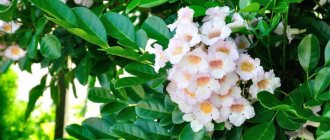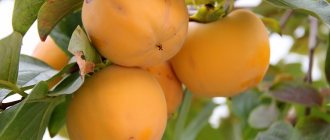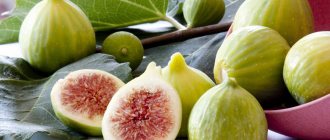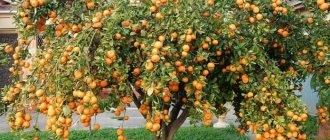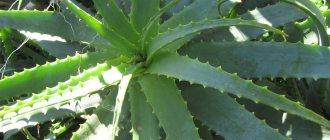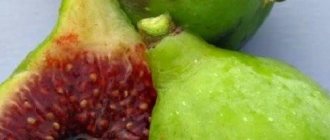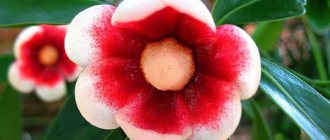Figs in the south, on the Black Sea coast, in Crimea, are a huge tree. Here, in Kuban, figs are more like a large bush. Although in Krasnodar in one of the parks I saw a fig tree. Of course, not as big as, for example, in Sochi, but still a tree. In our area it is recommended to grow it in the form of a bush, since it needs to be covered for the winter, like grapes. Growing figs, agricultural technology, features - this is what we will talk about now.
Figs have always been loved, even revered. The plant has several names. Fig, fig or fig tree, “wine berry” - from the genus-tribe of ficus. The word "fig" is of Turkic origin. But the generic name “ficus”, moving from west to east, gradually changed - it entered our language as the word “fig”.
Hence the “fig tree” mentioned in the sacred books, the “fig leaf” with which sculptors covered the nakedness of their statues (this expression later became a common noun). In ancient Russian books, the fig was called fig, and the tree was called fig tree. Now it is distributed throughout the Mediterranean and Black Sea coasts, in Asia Minor.
Figs, grapes, and olives were staple foods for many generations. Grapes and figs are mentioned together in the Bible because they were grown side by side. They were symbols of peace, eternal life, health, happiness.
Tree pruning
The most favorable climate for the growth of this representative of the flora is a moderate warm climate with a long summer period. In countries with similar weather conditions, growing figs is not particularly difficult. The height of the tree trunk without crown reaches 1.2 meters.
Under unfavorable climatic conditions, the fruiting of the plant decreases. To avoid this effect, you need to help the figs get rid of excess branches and direct the greatest flow of nutrients to the fruits. To do this, this representative of the flora is trimmed and shaped.
Routine pruning of figs in the fall helps the plant prepare for the cold season.
Removing many of the young shoots helps redirect the nutrient sap to the fruit, making the crop larger in size and increasing its volume.
To solve temperature problems, many gardeners place this plant in greenhouses. To ensure that the tree takes up less space, it is often grown indoors; this helps reduce the size of the tree and limit its growing area.
In cold climates, it is recommended to create a fan-shaped crown to cover the figs so that they survive the winter period safely. To further preserve heat, with the onset of cold weather, the figs are covered with straw mats.
Specifics of growing figs in Kuban
Figs grown in the Krasnodar Territory, as a rule, need to be covered for the winter in the same time frame as usual for grapes, that is, in October-November. By this time, the bulk of the fruits have already ripened, the leaves begin to lighten and separate freely. The average duration of the growing season is 215-220 days. Figs are sure to be covered when grown in our region. Together with the shoots, unripe fruits are hidden; they will give an early harvest next year. It must be covered in a prepared trench dug on the south side, 30-40 cm deep, along the length of the branches of the trunks.
Before covering, the entire trunk of a tree or bush can be whitened with lime or treated with a 3% solution of preparation No. 30, or a 1% solution of copper or iron sulfate. It is necessary to process the hole, all the plant mass with which you will cover the figs. For shelter, the bush must be tied with a wide ribbon; it should be bent to the ground gradually; if the height is 2.5-3 m or more, then this must be done over 3-5 days. Heavy objects are used for bending: tree trunks or reinforced concrete objects. When bending, the plant does not break at the bend, and no negative effects are observed. The prepared hole for shelter is covered with vegetation, and the top is covered with dry vegetation, then with film, paper or roofing felt, then with a layer of earth at least 20-25 cm thick.
If you grow bush figs, then it is not necessary to dig them in for the winter. You can simply tie the branches well with ropes to reduce the volume of the plant, then wrap them with burlap or several layers of the densest covering material - it is now freely sold in stores for gardeners. The area at the base of the trunk also needs to be insulated - add a mound of earth or cover the circle around the trunk with a layer of dry mown grass or straw.
Photo of a fig covered with polyethylene for the winter (unsuccessful experience of a neighbor in the country - the fig got stuck under the film)
It should be noted that ripe fig fruits are often damaged by bees or ants up to 10-15 percent. It is necessary to monitor the ripeness of the fruits more often and collect them on time.
Briefly about the agricultural technology of growing figs. There is another growing secret. The root system of the plant is well developed, penetrating 2.5 m or more. It starts almost from the very surface of the soil. Knowing this, the gardener must keep the tree trunk always in working order. What does it mean? This means that figs are one of those very demanding plants that breathe abundantly with oxygen through their roots, so their roots are located closer to the surface of the soil.
The question arises: how to loosen the tree trunk circle, because you can injure the roots? And the soil is trampled down, and the availability of oxygen drops sharply. What's the solution? It is necessary to apply the tinning method in the tree trunk circle. This means: allow the grass mixture (maybe even weeds) to grow to a height of 15-20 cm and mow it, leaving the grass mixture in the tree trunk circle. The mown grass of the second mowing and subsequent mowings will gradually, under the influence of moisture, undergo a process of mineralization by beneficial microorganisms. With this method, firstly, the soil of the root strip is little trampled down - oxygen will penetrate freely, and secondly, the mowed grass serves as mulch, which means that moisture also reaches the roots normally.
Figs are a plant of mild warm climates. Depending on the variety and growing conditions, it can withstand an absolute minimum of -12 to -16°C. Therefore, it is necessary to form a plant, taking into account the growing zone. On the coast, plants are given a standard form. In other areas of the region, the best are fan or bush formations.
When growing figs, it is necessary to pinch all young shoots 50-60 cm long, which ensures the appearance of more fruitful side shoots. Pruning should be done after leaf fall or in early spring, before the growing season begins. All cuts must be made “on the ring” with a well-sharpened knife, then immediately covered with garden varnish or paint prepared in vegetable oil. Strong pruning can cause negative consequences, since cuts in figs heal slowly, as a result of which the wood sometimes dries out at the ring.
The formation of fig plants begins after planting. Under cover culture conditions, plants are planted obliquely, at an angle of 20-40°, cut at a height of 10-15 cm from the soil surface, leaving 3-4 strong branches that serve as the base of the skeleton; the remaining branches are cut out. In the second or third year, shoots of the second or third order grow, on which a harvest of fruits is formed.
If fig trees are formed in a high-standard form, then the first pruning is done at a height of 80-100 cm from the soil surface, leaving 7-8 of the strongest shoots, on which second-order branches are laid. Then the shaping is carried out in such a way as to obtain a well-lit sparse crown. To enhance branching, young growing shoots are pinched. When forming with a low standard, the first pruning is carried out at a height of 30-50 cm. The result is a low-growing tree, convenient in all respects.
To avoid bare branches, excessive thickening of the crown, and the appearance of vertical shoots, pruning is used. The strength of pruning figs depends on the variety. Low-growing varieties with normal branches are pruned only if necessary. Vigorous varieties with small branches are pruned more heavily.
In subsequent years, the main, stronger lateral branches are shortened by about a third, taking into account the entire plant. Shoots of the second and third order are left in the amount necessary for normal crown formation. Excess shoots are cut off “into a ring.” Then only the thickening shoots are cleaned and the dry wood is removed. Mature plants usually do not need annual pruning. To restore the damaged part of the crown or the entire bush, shoots are used.
Currently, no diseases or pests have been observed on figs. But to increase the stability of the plant and increase productivity in spring and autumn, we apply organic fertilizers, and feed the leaves with microelements or a cheaper, accessible ash solution. We prepare the ash solution by infusion: 200-500 g of ash per 10 liters of water for 2-3 days, then drain the top layer, use it for foliar feeding, and pour the sediment into holes dug around the figs.
Creating a dwarf effect
If a plant is limited in the area of its root system, it will decrease in size due to a lack of nutrients coming from the roots. Therefore, to grow small figs at home, it is recommended to plant them in a container or hole.
To grow small figs at home, it is recommended to plant them in a container or hole.
The container area should not exceed 4 square meters. m. Along the perimeter it is fenced with stones or concrete. At the bottom of the hole or container there should be a layer of broken bricks or crushed stone.
Preparing figs for winter: main autumn activities
In fact, all autumn care for figs, or rather, their preparation for winter, comes down to proper shelter. It does not require any other measures (fertilizing, water-recharging watering). Unless you need to trim the shoots to mature wood and for the convenience of shelter.
By the way! Figs grown in containers (pots) are brought into a cool room (basement, cellar, loggia or glassed-in balcony) in the fall for wintering.
How to get berries to ripen
Very often, gardeners who grow figs in less than ideal conditions are faced with the fact that they simply do not ripen in the fall. The leaves have already fallen off, but the fruits are not ripe and were killed by frost.
What should we do, what should we do?
- Grow figs under a plastic greenhouse or in a greenhouse . Only in such (greenhouse) conditions can you increase the amount of positive temperatures required for the figs to fully ripen.
- In summer, be sure to pinch the shoots after 5-6 leaves, thus stopping the growth of green mass and redirecting the juices inside the plant to ripen the fruits of the 2nd harvest (autumn).
- Rate (pluck) part of the ovaries of the second harvest, without sparing them - everything will not ripen before the cold weather.
By the way! You can make delicious jam from unripe berries.
Difference in yield
Young gardeners do not know that figs (pruning and caring for them) are different from some other types of trees. A single fruiting branch will sometimes simultaneously produce figs in three stages of development. The first fruits to ripen are from buds that have survived cold times. Next, the nutrients are supplied to new shoots that grow in winter.
In native climatic conditions, such buds will produce new fruits by August. During the same period, replacement shoots appear that will bear fruit next year. The above cycles are typical for regions with long summers and a warm climate.
A single fruiting branch will sometimes simultaneously produce figs in three stages of development.
Due to the shorter hot period, spring shoots will not be able to fill with nutrients and ripen by September-November.
For other weather conditions, these fruiting rules may change significantly. Due to the shorter hot period, spring shoots will not be able to fill with nutrients and ripen by September-November.
In order for the fruits to ripen at the right time, the figs are formed and trimmed. The highest quality harvest can be obtained with one-year-old overwintered buds. Because of this pattern, gardeners cut off unnecessary plant elements to redirect nutrients to productive shoots.
What happens if you don't trim?
Fruit trees need to be pruned correctly. If you do not carry out this activity at all or do it incorrectly, this may cause a reduction in fruiting.
If the growth of shoots is not controlled, they will thicken the crown and reduce the illumination of branches with fruits. As a result, they will receive an insufficient amount of nutrients, which will affect the reduction in yield and improper formation of skeletal branches.
In addition, the procedure should be carried out on time. This will avoid many problems that usually arise during the period of growth and fruiting. If pruning is carried out according to all the rules, the figs will grow well and bear fruit.
When to prune a tree
Figs bear fruit twice a year: from March to June and from August to September.
Therefore, manipulations with this plant should be done in the spring after the end of the cold weather (March 10-30), but if the temperature does not reach +8 degrees, then the plant will not begin to reproduce and create buds for a new harvest.
Figs bear fruit twice a year: from March to June and from August to September.
Remember! If this regime cannot be achieved, then the growth of the plant can be stimulated by breaking off the tips of the leaves.
Such actions take away the nutritious juice and do not allow secondary figs to develop. By next spring, at the damaged sites, many shoots will grow, on which inflorescences will appear in hot weather.
By next spring, at the damaged sites, many shoots will grow, on which inflorescences will appear in hot weather.
To maintain the condition of the fig trunk, March-April:
- All frostbitten shoots are cut off.
- Remove small young branches directed inward (intersecting with other shoots). Reduce the number of branches in the middle of the crown to allow sunlight to reach the trunk.
- Old branches or those with a small number of shoots are cut off, leaving one bud. If there is none, then the branch is shortened to 50-80 mm. New shoots will grow at the damaged sites next year.
- Large fruits will not survive the winter, so they must be removed.
Features of winter care during the dormant period of figs
Fig tree or fig - description of what the fruit looks like
All representatives of the subtropics need a period of rest. Figs are no exception. Hibernation for this tree begins in late autumn. Already in November you can notice how the leaves begin to fall, this is evidence that the exotic beauty is preparing for the winter.
Many novice home garden connoisseurs are wondering: how to properly care for figs in winter? The answer is simple: this tree does not require any complex care during the cold season.
In October, you need to reduce the amount of watering. When all the leaves fall, this will mean that physiological rest has come for the exotic beauty. The bush is transferred to a cool, shaded place, where the temperature does not fall below 8-12°C and does not rise above this figure. Under no circumstances should you leave a flower to spend the winter on an open, unglazed balcony. From November to January, the tree is not fed; it is watered rarely and only so that the earthen ball does not dry out.
After a dormant period, the tree needs to be transplanted into a larger container, fed and brought into the light. Watering is resumed.
In winter, figs are transferred to a cool place where there are no sub-zero temperatures.
If the temperature regime and the basic rules of dormancy are observed in the winter season, figs, the cultivation of which at home does not cause anyone any trouble, will delight its owner in the spring with a strong root system, the ability for rapid growth and development, and a good harvest in the future.
Note! In winter, when watering the bush, you need to use cool water. This is necessary to prevent early awakening of the kidneys.
Creating the crown and side branches of a fig tree
If you don’t know how to prune figs in order to improve their fertility, then in the first years of life you need to create a strong vertical pole - a standard. When at least 3 side shoots appear on the primary shoot 0.5-1 meter high, then the formation of a tree can begin. Manipulations are carried out in February-March at a stable temperature above 8 degrees.
At low temperatures (up to 10 degrees) in the region in spring, you need to increase the crown in size and open it more to the sun. At temperatures above 20 degrees (late summer, early autumn), the purpose of pruning changes; it is necessary to destroy the lateral shoots, and instead keep the shoots in the middle of the crown, since its spreading leaves will protect the fruits from sunlight.
This shape of the fig tree resembles the fan formation of other fruit plants, but the branches are located at a greater distance from each other. For 2-3 years of life, figs must be tied to additional support (cellular trellises). In the future, fruitful branches will be tied to the auxiliary frame. Trellis must have a minimum height of 2.5 meters and width of 4 meters.
Preparing fig cuttings for planting in open ground
First you need to get fig cuttings. This is not difficult to do now; on the Internet there are many offers from amateur gardeners who offer a large assortment of varieties. You just need to stock up on cuttings in winter, or in early spring - before the growing season begins.
The standard is considered to be a stalk 10-25 cm long, as thick as a finger, with 3–4 buds. But this is the standard, and in practice all sorts of cuttings take root. The ends of the harvested fig cuttings should be dipped in melted paraffin to reduce moisture evaporation, but you can do without this operation.
Next, the fig cuttings are wiped with a weak (1:10) solution of hydrogen peroxide (disinfected), wrapped in a damp (not wet) cotton cloth and placed in a plastic bag. A tag with the name of the variety (if known) and the date is attached to the bag with the cuttings. Place in the vegetable compartment of the refrigerator (temperature +4...+5 degrees) and store until spring. Periodically, once every two weeks, the cuttings are taken out and inspected. If mold appears, wipe it with diluted peroxide, and if the fabric is dry, moisten it a little.
Fig cuttings are ready for rooting.
Rooting fig cuttings before planting in open ground
At the beginning of spring, fig cuttings can be rooted. Freshen the bottom cut with a sharp knife and make a few shallow scratches at the bottom, cutting through the bark. For good rooting, it is worth keeping the cuttings for the time prescribed according to the instructions in a solution of any rooting agent. Although many varieties take root easily without this.
Now we place the fig cuttings in some breathable and moisture-absorbing substrate. Some people use calcined sand, but I use either sphagnum moss or, as this season, coconut substrate. The main thing is that it is not wet and water does not flow from it, it must be wet.
Any container can be used as a container, but with holes made for air exchange: a plastic container with a lid, a plastic bag, two plastic cups, a container with a glass jar, etc. The temperature for rooting figs is +22…+25 degrees.
Propagation of figs by cuttings
The main method of propagating a fig tree is cuttings. When propagated by cuttings, the first harvest can be collected within a year.
Cut from below at an angle, a centimeter above the bud. The upper cut is made evenly, perpendicularly, a centimeter up from the bud. The cuttings are placed in warm water to speed up the release of milky juice. For the same purpose, the cuttings are kept in a cool (and dry!) place for about 6 hours. After the cutting has sap, its lower edge is cut and scratched longitudinally to stimulate root formation. Then the cuttings are placed in water with the addition of a root formation stimulator. After growing a good root system, the cuttings are planted in open ground.
Technology for planting figs in pits
To plant figs in open ground, a planting hole is required, the depth and diameter of which are 1 m. The bottom of the hole is covered with a 30-centimeter layer of drainage made of large expanded clay, crushed bricks, and pebbles. The walls are lined with broken bricks, stones, pieces of concrete, rubble stone and other similar materials.
Part of the pit is filled with a prepared mixture of topsoil with humus, leaf soil, and compost. They pour out a bucket of water. When the water is absorbed, a seedling is placed on a layer of fresh fertilized substrate so that the root collar is at the level of the edge of the hole or slightly lower, and the hole is filled with earth, distributing the soil between the roots, compacting and tamping. The tree trunk circle is mulched with humus or compost and watered thoroughly. At least two buckets of water are required for the first watering.
Peculiarities
In Crimea, the height of the fig tree reaches 3-5 meters. It has recognizable carved leaves and a spreading crown. Its fruits are round, fleshy, medium-sized berries. Figs will sing not just once, but several times throughout the summer. On one tree you can always see berries of varying degrees of ripeness. Since autumn is usually warm and long in Crimea, all the fruits have time to ripen before the onset of cold weather.
Interesting fact: if the winter is warm, pea-sized fruits that did not have time to grow this year can safely survive the winter and ripen next year.
Pruning figs in autumn to increase yield
Planted so that the top part is 5-6 cm above the soil, watered to fit the soil tightly around the cutting. In the book by Grekov S. During this time, they must be kept in a wet cloth, moistened as they dry. If, in addition, they are placed in a plastic bag, then its top should be open to avoid rotting of the buds of the cuttings. In this case, it all depends on the time of cutting the cuttings. It is advisable to plant cuttings immediately after they are delivered to the area where they will take root.
Considering the small quantities of rooted plants in amateur conditions, it is necessary to plant them in transparent containers for drinks and mineral water. The bottles are cut in half, only their lower part is used, in which holes are made with an awl for drainage. Fig cuttings are placed in each container, the lower end of which should be at a distance of cm from the bottom of the container. Planting depth - cm. After planting, the container with the cuttings is watered and placed in a warm, bright place, preferably on a radiator near a south-facing window.
After about a week, the cuttings begin to grow. By the end of April, from each survival of three in a pot, bushes of leaves are formed, and sometimes with a developing fruit. Plants acclimate to air over a period of weeks, and then to direct sunlight for the same period of time. After spring frosts, fig seedlings are planted either in a tub or in a permanent place of growth. Watering is done regularly, once a month, or more often.
Soil care involves loosening it to a depth of cm and removing weeds.
It is also advisable to fertilize with mineral or organic fertilizers once a summer. Feed with nitrogen fertilizers: 1 tablespoon of saltpeter per bucket of water. In autumn, standard seedlings have at least 30 cm of mature shoots with a diameter at the base of at least 3 mm; the length of the main roots is at least 20 cm with the number of heel roots at least four.
At the end of the growing season, around the end of September, fig seedlings are either buried in soil if in open ground, or covered if in a trench, or dug up with a large lump of earth and placed for wintering in a cool place with above-zero temperatures, preferably in the basement. The following year in April, the seedlings are planted in a permanent place of growth: in the ground if they intend to grow in the future, covered with rags, leaves, waterproof film, soil, in a trench or pot if they are further grown indoors.
Another option is possible. In the second year of planting, figs can be grown in open ground, then, at the end of the growing season in September, transplant the seedlings into pots of sufficient capacity, keep them for 3 - 4 months in a cool place, and in February - March place them indoors. For planting figs, choose areas protected from cold winds, southern-facing slopes with moisture-absorbing fertile soils, with good drainage, and not flooded.

